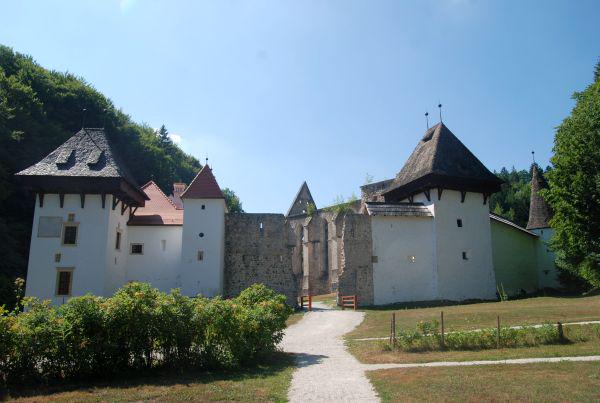
Hidden among the bucolic countryside of the Štajerska (Slovenian Styria) is a unique monastery: The Žiče Charterhouse. Much of the structure is in ruins nowadays, but the remaining architecture serves as a testament to the important role the monastery once played in the religious and secular life in this part of Europe.
The charterhouse – a monastery inhabited by monks of the Carthusian order – was founded in 1160 by Ottokar III, the Margrave of Styria. It was the first charterhouse outside France and Italy; in fact, its first resident monks are believed to have come from the monastery in Grenoble, France.
The importance of the Žiče Charterhouse increased after the East-West Christian schism, and the monastery eventually became the key charterhouse in German-dominated Europe. It soon gave rise to several daughter monasteries throughout Central Europe.
At its peak, the charterhouse included a dormitory, a dining room, a chapel, and a remarkable library, which contained secular and religious texts from around Europe. The monastery also had a manuscript workshop of its own; more than 2000 manuscripts were written here during the course of four centuries – one of the longest uninterrupted traditions of manuscript writing anywhere. The books produced there were not just religious in nature; they also covered such scientific fields as astronomy, and enabled accumulated knowledge to be passed down from generation to generation.
The books were also works of art. Many manuscripts were written by visiting monks, many of whom were among Europe’s best in their craft, and decorated by master illuminators, who specialized in equipping the books with intricate decorations. Eventually, a distinctive Žiče style of manuscripts emerged.
The charterhouse was also renowned for its apples, which were prized as far away as modern-day Germany, as well as its wine. In 1173, not long after the monastery opened its doors, Patriarch Ulrich Ii of Aquileia allowed the monks to set up their vineyards. Utilizing methods developed in France, the monks soon began to produce large quantities of wine and he charterhouse quickly became renowned as a wine-producing center.
The year 1783 saw an abrupt end to the monastery. That’s when the Hapsburg Emperor Joseph II, influenced by Enlightenment beliefs, decided to abolish all contemplative monasteries. Within a few decades, much of the monastery was already in ruin. In the aftermath of a strong earthquake that struck the town of Slovenske Konjice, many locals used stone and wood from the charterhouse as building materials.
Today, much of the monastery is still in ruin, but some of the old buildings have been lovingly restored. Among them is the Gastuž, the old monastic restaurant. Because the charterhouse itself was off-limits to outsiders, visitors were traditionally received in the inn, where they were offered food and drink. The restaurant has now reopened and offers dishes prepared using traditional methods from old monastic records. It is the oldest functioning restaurant in all of Central Europe.
Visitors can also visit the charterhouse’s pharmacy. It continues the monastery’s long tradition of herbalism by selling various home remedies. But the greatest legacy of the monastery extends beyond the buildings – it takes the form of knowledge that has been preserved through the centuries thanks to the work of the monks and their determination to understand the world around them.
Jaka Bartolj

































































